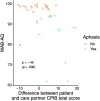Assessing Patients and Care Partner Ratings of Communication-Related Participation Restrictions: Insights From Degenerative Disease
- PMID: 36758199
- PMCID: PMC10561959
- DOI: 10.1044/2022_AJSLP-22-00140
Assessing Patients and Care Partner Ratings of Communication-Related Participation Restrictions: Insights From Degenerative Disease
Abstract
Purpose: Prior studies have shown that communication-related participation restrictions in patients with degenerative disease do not always match clinician judgment or objective indices of symptom severity. Although there is a growing body of literature documenting that discrepancies between patients with dementia and their care partners' perception of participation restrictions exist, it is not known how care partner perceptions of communication participation restrictions specifically match or diverge from the patients' experiences, which may inform the use of care partner proxy in the context of degenerative diseases.
Method: Thirty-eight patients with progressive neurologic conditions (progressive supranuclear palsy, corticobasal syndrome, and primary progressive aphasia or apraxia of speech) and, in most instances, focal cognitive-communication disorders were included. The patients and their accompanying care partners independently completed the Communicative Participation Item Bank, short form, a 10-question survey about communication participation restrictions in different contexts. Care partners were instructed to complete the form with their perception of the patient's experience. The difference between patient and care partner total scores were calculated and analyzed relative to clinical and demographic variables of interest.
Results: Care partner ratings modestly tracked with patient experience and objective indices of symptom severity but did not exactly match patient ratings. The presence of aphasia increased, but did not fully account for, the likelihood of a discrepancy between care partner and patient ratings.
Conclusion: Although careful consideration should be given prior to using care-partner report as a proxy for patient experience, it is worthwhile to include care partner ratings as a means of supporting conversations about differing perceptions, guiding joint intervention planning, and monitoring care-partner perceptions of change along with the implementation of supported conversation strategies.
Figures









Similar articles
-
Assessing Change in Communication Limitations in Primary Progressive Apraxia of Speech and Aphasia: A 1-Year Follow-Up Study.Am J Speech Lang Pathol. 2021 Nov 4;30(6):2368-2378. doi: 10.1044/2021_AJSLP-20-00402. Epub 2021 Sep 7. Am J Speech Lang Pathol. 2021. PMID: 34491800 Free PMC article.
-
On the diverse outcome of communication partner training of significant others of people with aphasia: an experimental study of six cases.Int J Lang Commun Disord. 2016 Jul;51(4):402-14. doi: 10.1111/1460-6984.12216. Epub 2016 Mar 6. Int J Lang Commun Disord. 2016. PMID: 26947265
-
Communication Limitations in Patients With Progressive Apraxia of Speech and Aphasia.Am J Speech Lang Pathol. 2020 Nov 12;29(4):1976-1986. doi: 10.1044/2020_AJSLP-20-00012. Epub 2020 Aug 5. Am J Speech Lang Pathol. 2020. PMID: 32755493 Free PMC article.
-
Discourse-Level Communication Success in Aphasia: Unveiling Its Significance through Observer's Ratings.Semin Speech Lang. 2024 Aug;45(4):381-400. doi: 10.1055/s-0044-1789622. Epub 2024 Oct 3. Semin Speech Lang. 2024. PMID: 39362267 Review.
-
Behavioral interventions for primary progressive aphasia.Handb Clin Neurol. 2022;185:221-240. doi: 10.1016/B978-0-12-823384-9.00011-6. Handb Clin Neurol. 2022. PMID: 35078600 Review.
References
-
- Armstrong, M. J. , Litvan, I. , Lang, A. E. , Bak, T. H. , Bhatia, K. P. , Borroni, B. , Boxer, A. L. , Dickson, D. W. , Grossman, M. , Hallett, M. , Josephs, K. A. , Kertesz, A. , Lee, S. E. , Miller, B. L. , Reich, S. G. , Riley, D. E. , Tolosa, E. , Tröster, A. I. , Vidailhet, M. , & Weiner, W. J. (2013). Criteria for the diagnosis of corticobasal degeneration. Neurology, 80(5), 496–503. 10.1212/WNL.0b013e31827f0fd1 - DOI - PMC - PubMed
-
- Baylor, C. , Eadie, T. , & Yorkston, K. (2021). The Communicative Participation Item Bank: Evaluating, and reevaluating, its use across communication disorders in adults. Seminars in Speech and Language, 42(3), 225–239. - PubMed
-
- Baylor, C. , Oelke, M. , Bamer, A. , Hunsaker, E. , Off, C. , Wallace, S. E. , & Yorkston, K. (2017). Validating the Communicative Participation Item Bank (CPIB) for use with people with aphasia: An analysis of Differential Item Function (DIF). Aphasiology, 31(8), 861–878. 10.1080/02687038.2016.1225274 - DOI - PMC - PubMed
-
- Baylor, C. , Yorkston, K. , Eadie, T. , Kim, J. , Chung, H. , & Amtmann, D. (2013). The Communicative Participation Item Bank (CPIB): Item bank calibration and development of a disorder-generic short form. Journal of Speech, Language, and Hearing Research, 56(4), 1190–1208. 10.1044/1092-4388(2012/12-0140) - DOI - PMC - PubMed
Publication types
MeSH terms
Grants and funding
LinkOut - more resources
Full Text Sources
Medical

